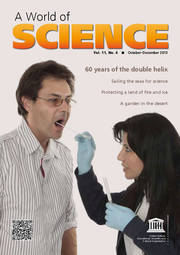Vol 5 N° 2 [April–June 2007]
CONTENTS
IN FOCUS
p 2 - Far from the nanohype
NEWS
p 8 - A global warning on global warming
p 9 - UNESCO and ESA to map Mesoamerica’s biological corridor
p 10 - A robot camp for kids
p 10 - World water programme to move to Italy
p 11 - Palestinians gain Chair in maths and physics
p 11 - Africa commits to research
p 12 - US$30 million loan for Mayan Biosphere Reserve
p 13 - Full-time seismic coverage for Europe's seas
p 13 - Half a million dollars for top women scientists
INTERVIEW
p 14 -Igor Vasilievich Severskiy onwhy glacier melt and poorpolicies are to blame for Central Asia’s water woes
HORIZONS
p 16 - Saving the remaining wildlife in Darfur
p 21 -Head counts and headaches measuring women in science
IN BRIEF
p 24 - Diary
p 24 - New releases
Quick link to A World of Science Vol. 5 n° 2 (PDF document);
See also ARCHIVES for A World of Science
EDITORIAL
The glass ceiling
A decade ago, UNESCO launched a programme for Women, Science and Technology. Some might be tempted to consider such a programme of secondary importance, in light of such momentous problems as extreme poverty,pandemics, climate change and so on. At a time when the planet is fighting for its survival, does UNESCO have nothing better to do than set up prizes and fellowships for women and promote science education for girls?.
Let’s examine the situation for a moment. The latest data published by theUNESCO Institute for Statistics, reproduced in this issue, reveal that science and technology are still dominated by men. Women represent just one-quarter of the world’s researchers, roughly 10% of university professors and fewer than 5% of members of Academies of Sciences. As for Nobel Prize laureates in science, fewer than 3% have been women.
It is true that the life sciences often attract more women than men but, even here, women soon strike a `glass ceiling´ when they try climbing the career ladder. ‘Our male colleagues do not readily accept women’, regrets Professor Ameenah Gurib-Fakim, one of this year’s five L’ORÉAL–UNESCO laureates.‘For a woman to make it, her portfolio has to be ten times heavier than that of her male counterpart.’
Even in countries which have achieved gender parity, such as Argentina,Thailand or Kazakhstan, the glass ceiling remains a common fixture. Yet, like any new population, the influx of women into the profession is slowly but surely changing the face of research. Women are bringing fresh approaches and pointsof view which can only nurture progress. They are beginning to influence the science agenda, thanks to a growing presence on scientific boards. They are adding value to innovation, not least because they bring ‘insider information’ on the needs and aspirations of the female consumer to the development of products and services.
The glass ceiling won’t shatter overnight. But I am proud to think that UNESCO’s partnership with L’ORÉAL, which has already distinguished 350 women scientists around the world in its first nine years of existence, will have helped to put a few chinks in it.
W. Erdelen
Assistant Director-General for Natural Sciences

